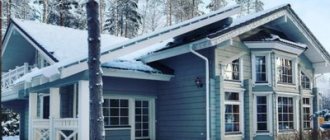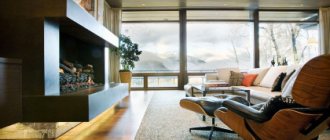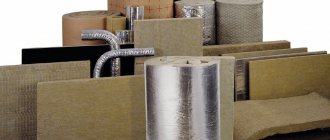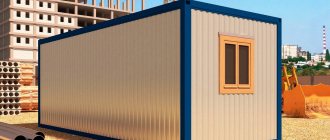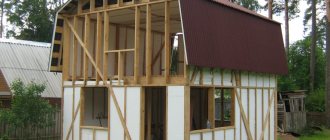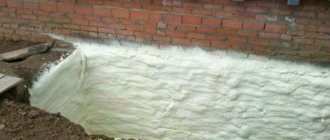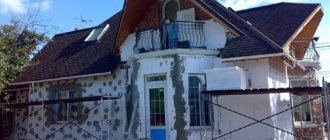A considerable part of city residents note that the comfort of living in an apartment can become boring over time. The dream of many is, after some time, to become the owner of real estate located outside the city limits. Often events develop according to the following scenario: a plot of land is acquired in an area where construction is permitted, and a frame house is erected. The use of this technology guarantees both speed of work and minimal financial costs for construction. In addition, if a frame house has high-quality insulation, such a home is distinguished by a high level of comfort for residents, regardless of the time of year and the air temperature outside. Such a building can be fully used not only for living in the warm season, but also as a permanent home for all family members.
Expert opinion
Konstantin Alexandrovich
The construction of the walls of a house built using frame technology already initially includes a layer of thermal insulation, which is protected on both sides by sheathing material. With thermal insulation of the floor, the situation is different; the principles of its arrangement may vary. They will depend both on the type of foundation of the building and on the climate in the region of residence, as well as on the wishes of the building owner. Insulating the floor in a frame house will minimize heat loss and create the most comfortable conditions for residents in any season.
How to insulate the outside walls of a panel house
A panel house on a wooden frame is not a log house made of logs or timber. In this case, there is no need to talk about the breathing properties (gas permeability) of the walls. Firstly, a continuous layer of vapor barrier is laid on the inside. Secondly, the vapor permeability of plywood or OSB boards with which the frame is sheathed is very low. Therefore, for external insulation you can use those materials that are not used for wooden houses:
- expanded polystyrene;
- EPPS (extruded polystyrene foam);
- sprayed thermal insulation based on two-component or one-component polyurethane foam.
Video description
We will dwell in more detail on insulating a house with polystyrene foam. Find out how safe polystyrene foam is in our video:
It is impossible to ignite mineral wool even with the flame of a gas burner Source krovlyakryshi.ru
It is easy to compensate for lower thermal insulation properties due to thickness. External insulation is not internal, and a few extra centimeters of insulation mean nothing. It is necessary to insulate with hard mats - rolled materials in vertical structures “move out” over time. And you have to choose between a thickness of 5 cm and 10 cm. For central Russia, provided that mineral wool 10 cm thick is already laid inside the walls, an additional 5 cm of thermal insulation layer is sufficient. Plus the thickness of double-sided wall cladding, interior trim and façade panels.
But if the budget allows, you can lay a layer 10 cm thick.
Selection of thermal insulation material
Materials for floor insulation in a frame house are presented in a wide range. The choice of one or another of them depends on the characteristics of the house being built and its heating system, and the climatic conditions of the region.
- Expanded clay - rounded elements made of baked clay. Despite the porous structure, it has high strength, is resistant to temperature changes and aggressive substances. The heat saving indicator is average, but expanded clay is perfect for insulating floors on the ground.
- Mineral wool is thin fibers pressed into mats from molten glass waste, quartz sand, and certain rocks. Available in the form of rolled mats or slabs. Lightweight, inexpensive and heat-intensive material. It loses its properties when wet and is absolutely not suitable for laying under a concrete screed.
- Extruded polystyrene foam is a fairly dense material with gas-filled cells. It surpasses traditional foam plastic not only in terms of thermal conductivity, but also in rigidity and fire safety. The main disadvantage is that when exposed to high temperatures, it releases toxic substances into the air.
- Polyurethane foam is a sprayed insulating material with a low thermal conductivity coefficient. Perfectly fills all voids, eliminating the formation of cold bridges, is resistant to ultraviolet radiation and fire, and does not emit toxic substances. The disadvantage is the use of special equipment and the high price.
Useful: Building a warm frame house
In each case, they individually determine not only what and how to insulate the floor in a frame house, but also how thick the thermal insulation layer will be. To do this, careful calculations are carried out at the design stage of the structure.
How to insulate walls outside
How to insulate a frame house for winter living:
- “foreign” objects must be removed from the surface of the external walls - ebbs, cornices, canopies, brackets for mounting lighting fixtures and attachments;
- remove the old finish - dismantle the trim, clean the paintwork;
- make markings for the sheathing , taking into account the width of the insulation mats;
- treat all wooden elements of the sheathing with an antiseptic;
- install a timber sheathing with a height equal to the thickness of the insulation;
The vertical lathing for external insulation of the pediment and walls does not have to coincide with each other. The main thing is that the step matches the width of the mats Source ekoplat.ru
- fix the insulation between the sheathing;
- lay a continuous layer, with overlapping sheets, of a superdiffusion waterproofing membrane , secure it to the sheathing;
- fill the counter-lattice beam , which should provide a ventilation gap and serve as a place for attaching facade panels (the height of the beam must be at least 6 cm - this is the minimum size of the ventilation gap);
- cover the facade with siding, block house or any other finishing materials for a ventilated facade.
Important! Even before insulation, it is necessary to replace the windows with a “winter” version. It is also necessary to insulate the entrance area - arrange a small vestibule and install a second entrance door.
Additional insulation of a panel house can be carried out along a horizontal lathing, and the counter-lattice can be made vertical to create a ventilated gap and fasten the sheathing.
Installation of slab insulation and roll insulation
If the floor of a frame house is based on logs, roll insulation can be laid between them. Its installation scheme is quite simple. First you need to measure the distance between the lags. If the width of the thermal insulation material is greater, it will need to be trimmed. To minimize the cost of thermal insulation material, it is recommended to install logs at a distance equal to the width of the insulating material. The slab material must fit tightly between the joists. It is important to correctly lay all the elements with a minimum number of gaps. All joints can be filled with polyurethane foam or covered with special tape.
Base insulation
Full insulation of a panel house from the outside will require work on the thermal insulation of the base for a strip base or a fence for a pile foundation.
Insulation of the base of a strip foundation
According to experts, a house through the foundation loses up to 10-15% of the total heat loss due to the fairly high thermal conductivity of reinforced concrete or building blocks (depending on what the base is made of). And this phenomenon must also be fought.
This is what the general diagram of heat loss through the enclosing surfaces looks like Source valet.ru
In this case, it is better to choose EPS for insulation. It is difficult to protect mineral wool near the ground from moisture as part of a “wet” facade (especially a curtain wall). Extruded polystyrene foam has a very low water absorption coefficient, and can even successfully perform waterproofing functions.
How to insulate a panel house for winter living using “wet facade” technology :
- prepare the surface of the base - clean it from dirt, if necessary level it with cement mortar, treat it with a primer for deep penetration concrete;
- attach the slab to the adhesive solution and additionally fix it with mechanical fasteners;
- apply a layer of adhesive solution , reinforce it with a mesh, pressing it into the solution, level the surface;
- cover the base with tiles made of artificial or natural stone.
If the finishing is carried out with basement siding or fiber cement panels, then the insulation has the following scheme :
- prepare the surface;
- install brackets for the sheathing;
- slabs are secured using glue plus mechanical fasteners;
- the seams are blown with foam;
- install a vertical sheathing made of galvanized profile on the brackets;
- cover the sheathing with panels;
- cover the base with ebb on top.
Basement insulation with EPS slabs and stone paneling Source homesto.ru
Heated floor systems with water and electric circuits
In addition to thermal insulation of the floor using materials with low thermal conductivity, additional heating systems using water and electricity are often used for frame houses. Their installation is carried out after laying the insulation and installing reflective screens. Otherwise, there is simply no point in installing such a system. An important point is high-quality sealing of all joints. All areas of low temperatures are insulated, and the joints of the windproof film are insulated with tape.
In a house that is just planned to be built, it is advisable to consider the presence of a water heated floor system. Its installation is extremely simple - plastic pipes are simply laid under the finishing flooring. In addition, installing a water circuit quickly pays for itself by saving on coolants.
If it is not possible to install a water system, electric heating methods are used. The following types of similar sex are distinguished:
- Based on heated mats. This option is the most inexpensive. Roll coverings are mats on a self-adhesive base, consisting of a polymer mesh and a cable arranged in a certain way. The mesh is installed using glue directly on top of the screed. These mats are convenient because they can be installed in areas that are difficult to access - in the bathroom and kitchen, under floors made of stone, porcelain stoneware or old tiles. But such mats require high-quality ventilation, otherwise they will quickly fail.
- Cable based floor. A resist cable is used as a heating element, which is laid out in the shape of the Latin letter S or in a spiral. Such a wire is mounted into the thickness of the concrete screed, and then a temperature controller is connected to it. The distance between the cable fragments should be from 6 to 12 centimeters. The thickness of the concrete screed can vary from 5 to 7 centimeters, and its top layer must be wet. As a result, you get a sectional floor covering with a double insulating layer. Before laying wires on the surface of the insulation, experts advise laying a layer of mesh.
- Using infrared coating. Sold in the form of convenient rolls, it works on the principle of emitting long-length infrared waves. The film contains graphite or carbon layers, copper tires, silver paste and contacts. To ensure moisture protection, a laminated layer is applied on both sides. Infrared waves do not pose the slightest danger to people. To install such a warm floor, you do not need to install a screed; it can be easily fixed even on an ordinary carpet. The only limitation on the use of infrared floors concerns rooms with high humidity levels.
A professional with experience in this field will help you choose the most preferable heating system for your case. The selection is carried out taking into account the nuances of the building itself, the site and the climatic characteristics of the region. If necessary, thermal calculations can be made. Installation of any type of system must be carried out in strict accordance with a set of certain rules. This will help avoid operational errors that could negatively affect the performance of the heating system. Competent work will guarantee comfort and warmth inside your home.
How to insulate a floor
Thermal insulation of the floor is already a technology for insulating a panel house from the inside. From the point of view of heating engineering, the insulated floor of a wooden house is a single-layer structure that simultaneously performs load-bearing and thermal insulation functions. There are different options for arranging a heated floor in a panel house, but they all come down to thin-layer cladding of a load-bearing wooden frame, inside of which heat-insulating materials are placed. And in order to protect the insulation from exposure to moisture and water vapor, it must be protected by continuous layers of vapor and waterproofing.
There are certain differences in the insulation of the floors of an apartment building and a private house. In an apartment building, the floor insulation must be protected from the penetration of water vapor from below, from the side of another heated apartment. And here the vapor barrier is spread over the ceiling (from below relative to the insulation).
In a panel house, the partial pressure of water vapor in the warm air inside the room is higher than in the cold air from the side of the pile or strip foundation. Therefore, a vapor-impermeable barrier should be on the floor covering side.
One of the possible schemes for installing an insulated floor. Regardless of the materials of the floor covering and subfloor filing, the order of layers does not change Source abisgroup.ru
There are different options for arranging an insulated wooden floor, but the principle is common to all, and the diagram looks like this :
- boards ;
- continuous layer of waterproofing membrane ;
- insulation;
- continuous layer of vapor barrier ;
- finishing floor .
Important! Moisture from the insulation should be ventilated into the underground, and from there through the vents to the street.
Thermal insulation of the attic room
Insulation of a panel house with an attic requires thermal insulation of the second floor. This can be done in two ways:
- Perform insulation along the contour of the attic room itself;
- Insulate the roof.
In any case, the entire plane of the truss structure from the roofing side, in front of the continuous decking or sheathing, is covered with waterproofing material (membrane). If the roof covering is metal, a technical gap must be left between it and the waterproofing layer to remove moisture from under the roof and allow condensation to drain onto the drip line.
